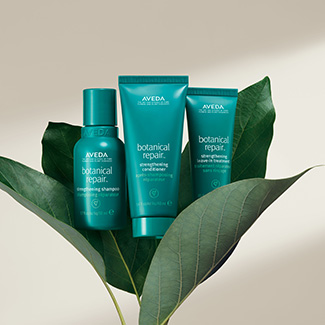By Laurel Nelson, a contributing writer with Salon Today
July 8, 2021
Every year, consumers become more and more savvy about the
beauty products they use on a daily basis. They read labels, look
for organic ingredients, and seek out green companies—something savvy salon owners have been doing for years.
Tracey Franklin, owner of Loxx Salon in Cookeville, Tennessee,
switched over to Aveda color four years ago after more than a decade using other brands.
“What drew me to Aveda was its naturally derived, sustainably sourced ingredients used to create a cruelty-free product,” she says. “And the education and support I receive is incredible—it’s more than I could ever consume, but having a constant source of education in person and on the PurePro™ platform is invaluable for myself and my team. If my stylists have downtime, they have education at their fingertips whenever they want.”
In the beauty industry, Aveda is the gold standard for organic, sustainably sourced ingredients, setting the bar for other companies (most recently converting all formulas to vegan) for four decades.
As consumers more closely scrutinize the color their salon is using, Aveda continues to stand out.
“You always hear that Aveda hair color is 93 percent naturally derived,” says Alberto Swanson,
executive director of hair color sales and education at Neill. “But no other color manufacturer states the percentage of ingredients that are naturally derived. Instead, they pick and choose what to highlight.”
In that picking and choosing, some myths have been generated about organic ingredients, the safety of ammonia, and product sourcing—and it’s time to set the record straight.
MYTH: Avoid ammonia at all costs
TRUTH: Ammonia occurs naturally in nature
That’s right. It has become trendy to highlight “ammonia-free” formulas as a more “natural” choice. But in fact, ammonia is a naturally occurring gas released in nature. It’s natural and organic—and we breathe it in daily.
In order for permanent hair color to work, you must have an alkalizer like ammonia to open the cuticle.
“Ammonia is necessary to achieve the results people want,” Franklin says. “You can’t get lift or gray coverage without it, and to villainize it is irrational because it’s used at safe levels.”
So—what are these “ammonia-free” formulas using instead? To Sean Hatcher, hair color and technical education manager at The Salon People, it’s as simple as an ingredients comparison:
HAIR COLOR’S TOP MYTHS
“Think of a can of Coke. If you make it sugar-free, you still need something to sweeten it. So out goes the sugar, and in comes a chemical to replace it.”
The same goes with ammonia. It gets replaced with MEA (monoethanolamine), an organic chemical compound made up of amine and alcohol.
MYTH: MEA is a safer, more effective alternative to ammonia
TRUTH: MEA is less effective and can cause irritation if not properly rinsed from hair
Unlike ammonia, which is a gas-based chemical and evaporates out of the hair quickly, MEAs are in liquid form, which means they must be removed once applied to the hair.
“MEA has to be properly removed from the hair so it doesn’t stay in contact with human
skin,” Swanson says. “A thorough shampoo is often overlooked, which won’t affect someone when using ammonia-based color. But it must be done properly every time with MEA.
“Don’t be fooled by the ‘ammonia-free’ discussion in color right now,” Swanson says. “Ammonia is the highest performing alkalizer in hair color. Color with MEA has limitations—it doesn’t last as long or lift as well.”
MYTH: Ammonia’s aroma offends guests
TRUTH: The aroma dissipates in seconds
One reason ammonia has a bad reputation is its unpleasant aroma. And with Aveda color, no synthetic perfumes are used to mask the smell—the product scent comes solely from the natural ingredients used.
“Aveda’s not going to compromise the integrity of our color by putting an artificial scent in,” says Hatcher. “There’s a better fix—right at the color bar.”
Swanson explains, “You can make the ammonia smell go away by stirring the color and properly aerating it. This allows the scent to ‘flash’ or dissipate.”
Hatcher adds, “It only smells for about 15 seconds, but is very noticeable if you do it next to a guest’s head by the bowl. So mix it up at the color bar or shake the bottle and take your finger off to let it breathe before heading back to your guest.”
At Loxx, Franklin says color is mixed at the color bar, away from guests. “We’ve never had any complaints—just compliments on the Aveda aroma,” she says.
“I remember the first time I opened Aveda’s lightener—I was shocked by how good it smelled!”
Naturally derived and high-performing, ammonia is the alkalizer used in Aveda color. But as always, Aveda’s scientists continue to explore ways to make its color more environmentally friendly and natural without sacrificing performance.
MYTH: All color lines use the same amount of synthetic dye
TRUTH: Aveda’s green tea technology creates a formula that uses less synthetic dye than other lines
HAIR COLOR’S TOP MYTHS
There’s a reason Aveda artists are passionate about its color line: it’s designed just for them. And the green tea technology used in Aveda color gives colorists greater versatility with shades, while using less synthetic dye.
The amount of synthetic dye used in Aveda color is significantly less than in other brands due to the use of green tea as a coupler (a coupler is used in hair color to take the oxygen out of the air and put the dye to work).
“Aveda uses a patented technology that uses a coupler from a naturally derived source—green tea,”
Hatcher says. “We were able to take something historically done in a test tube and use a natural process.”
“Green tea extract creates a broader color model molecule. You can create multifaceted shades because of that technology Horst founded.”
Other color manufacturers have to use more dyes to produce shade ranges, Swanson explains.
“Because of the green tea technology, we can use less synthetic dyes, which makes our color less harmful, with a smaller chance of hair color allergies,” he adds.
“Aveda is more customizable than other lines when it comes to getting the exact shade you want to see, and for gray coverage,” says Derek Piekarski, North America technical capability manager for Aveda.
“You have the option to add in as much pigment as you want and can truly customize to each guest’s specific needs.”
Franklin adds, “Transitioning to Aveda was intimidating at first. But once we got acclimated to mixing in the pigments, the unbelievable artistic value in customizing color was incomparable. What intimidated us at first inspires us now.”
MYTH: You must use a chemical to thicken color
TRUTH: Natural surfactants work just as well
Once again, when Aveda examined the ingredients in its color, they found a way to replace a chemical.
In this case, it was the surfactant that makes its color thicken (surfactants are compounds that lower the surface tension between two liquids, between a gas and a liquid, or between a liquid and a solid.
Surfactants may act as detergents, wetting agents, emulsifiers, foaming agents, or dispersants).
Aveda uses corn as a surfactant in its color formulas.“It helps the color spread throughout the hair using a natural ingredient,” Hatcher says. “It creates bubbles and makes the product expand/thicken. Other companies are still using chemicals as a surfactant.”
Mobile phones/QR codes trace each vanilla bean’s journey through the
supply chain.
MYTH: All ingredients are equal
TRUTH: Sourcing paths are often hidden
HAIR COLOR’S TOP MYTHS
Visit Aveda’s site, read its product labels, or talk to an Aveda team member and you’ll learn about the naturally derived ingredients in each and every product. Educating colorists and consumers is a top priority, so Aveda provides total transparency.
In 2019, Aveda took that transparency to the next level when it launched a pilot program in its Madagascan vanilla supply chain, using blockchain technology to verify the source and quality of
ingredients used in its products.
Using mobile phones and QR codes, Wholechain, Aveda’s blockchain innovation partner, created a tamper-proof record using blockchain tracing of each vanilla bean’s journey throughout the supply chain.
This cutting-edge traceability shows Aveda’s commitment to sustainable, responsible sourcing, high quality ingredients, and establishes best practices for the beauty industry and beyond.
“There’s not even a close competitor to Aveda when it comes to this,” Piekarski says. “You can track all our ingredients down to the source. And if it’s not 100-percent naturally derived, it’s because there was no natural alternative (such as an emulsifier or solvent).”
And now, these ingredients are also 100 percent vegan.
“The level of detail Aveda has reached to independently certify our sourcing is so high, an average consumer probably isn’t even aware of it,” Hatcher says.
“Sustainably sourced, naturally derived, vegan—and high performing,” Piekarski adds. “Aveda has the highest standards in ingredients, making it a true luxury brand.”
Hatcher adds, “It has always been about sustainability and choosing ingredients that are best for us and for the environment at Aveda.”
***This is why Atelier, the Aveda salon in Santana Row, uses Aveda haircolor exclusively. Healthy haircolor made with vegan ingredients is very important to our stylists and our guests.
Source: Aveda
[Reposted from Aveda Means Business]




